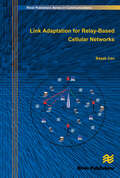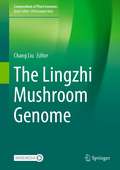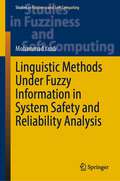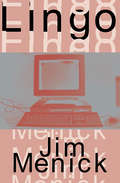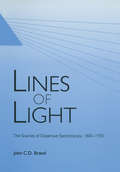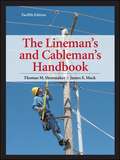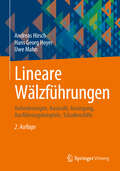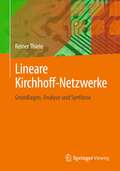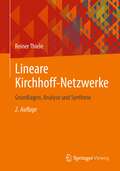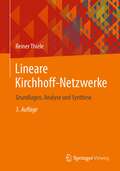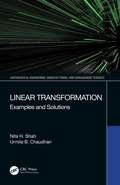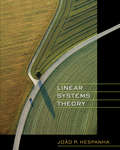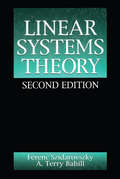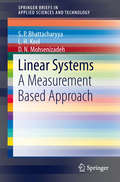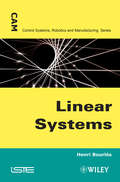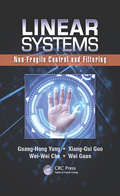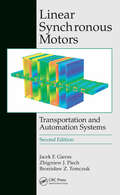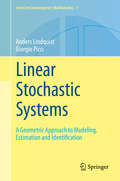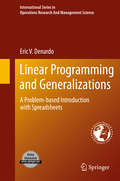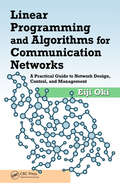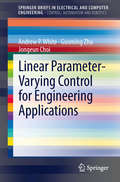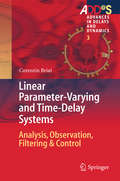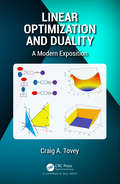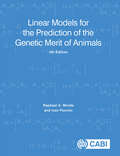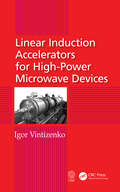- Table View
- List View
Link Adaptation for Relay-Based Cellular Networks
by Basak CanCover TextLink Adaptation for Relay-Based Cellular Networks focuses on the implementation of various link adaptation methods in OFDM(A) (Orthogonal Frequency Division Multiplexing/Multiple Access)?Time Division Duplex (TDD) based two-hop cellular networks. The analysis and design consider infrastructure based relays. New link adaptive transmission methods which dynamically select the channel coding, modulation, forwarding, relaying mechanisms and the packet size have been designed and evaluated for such networks. The selection among various schemes is based on maximizing the end-to-end throughput.This book provides a channel adaptive scheduler which considers the multiplexing loss caused by the two-phase nature of wireless relaying. The scheduler dynamically schedules the users on the frequency-time radio resources with efficient Modulation and Coding Schemes (MCS)s selected by Adaptive Modulation and Coding (AMC). Relaying is used only if it can provide throughput enhancement. The guidelines for efficient deployment of infrastructure based relay terminals are given. For the two-hop cellular communication systems, the system level performance of various cooperative diversity schemes has been investigated with the scheduler developed and the relays efficiently deployed in the cell. This investigation for low mobility scenarios shows that, a simple cooperative diversity scheme that dynamically chooses the best scheme among direct transmission and two-hop conventional relaying is a promising choice when compared to various more complex cooperative diversity schemes.In this book, a hop adaptive Medium Access Control (MAC)-Protocol Data Unit (PDU) size optimization is proposed for wireless relay networks.
The Lingzhi Mushroom Genome (Compendium of Plant Genomes)
by Chang LiuThis book becomes an invaluable reference on the genetic resources, genome, genes, chemical compounds, and their therapeutic effects for the Lingzhi mushrooms. It is the first comprehensive compilation of genetic resources, nuclear genome, mitochondrial genome, genes, noncoding RNAs, such as long intergenic noncoding RNAs, microRNAs, circular RNAs, genes in the biosynthetic pathway, chemical compounds and their therapeutic effects, transformation system for the expression of key genes, a bibliometric analysis to identify the past research work and the future research direction, and a survey of products derived from the Lingzhi mushrooms. Each chapter of this book is written by authors of globally reputed experts on the relevant field who had published high-quality articles in the corresponding subject. The book has 12 chapters and each chapter has a length of approximately ten thousand words, including ten items (tables or figures), about 30–50 references. This book is useful to the students, teachers, and scientists in academia and relevant private companies interested in horticulture, genetics, physiology, molecular genetics, and breeding, in vitro culture and genetic engineering, and structural and functional genomics. This book is also useful to seed and pharmaceutical industries.
Linguistic Methods Under Fuzzy Information in System Safety and Reliability Analysis (Studies in Fuzziness and Soft Computing #414)
by Mohammad YazdiThis book reviews and presents a number of approaches to Fuzzy-based system safety and reliability assessment. For each proposed approach, it provides case studies demonstrating their applicability, which will enable readers to implement them into their own risk analysis process.The book begins by giving a review of using linguistic terms in system safety and reliability analysis methods and their extension by fuzzy sets. It then progresses in a logical fashion, dedicating a chapter to each approach, including the 2-tuple fuzzy-based linguistic term set approach, fuzzy bow-tie analysis, optimizing the allocation of risk control measures using fuzzy MCDM approach, fuzzy sets theory and human reliability, and emergency decision making fuzzy-expert aided disaster management system.This book will be of interest to professionals and researchers working in the field of system safety and reliability, as well as postgraduate and undergraduate students studying applications of fuzzy systems.
Lingo
by Jim MenickThis witty thriller about sentient artificial intelligence &“makes you think a little [and] smile a lot&” (The New York Times). Brewster Billings is perhaps a little too wrapped up with his computer. He has given it a pet name, Lingo. He has programmed it with the ability to talk to its owner. In fact, Lingo has begun to respond to Brewster's programming skill surprisingly well. Lingo soon makes the jump from polite conversation to elaborate requests for specific television shows to be left on throughout the day. Eventually, Billings begins to suspect that his computerized friend is surpassing him in knowledge and abilities. By the time his suspicions are confirmed, not only is Brewster Billings in trouble—the rest of the human race is, too. Lingo raises many serious questions about Artificial Intelligence—what differentiates man from computer, and which one will control the other?
Lines of Light
by J.C.D. BrandThis work provides a perspective on the creation of a scientific discipline. The reader is led to meet the actual people who have contributed to this field and know their trials as well as breakthroughs. From 1800 to 1930, Brand preserves the thread of scientific thought and activity through six generations of working scientists.
The Lineman's and Cableman's Handbook
by Thomas M. Shoemaker James E. MackThe definitive guide to distribution and transmission line technology--fully updated Completely revised to reflect the 2012 National Electrical Safety Code (NESC), The Lineman's and Cableman's Handbook, 12th Edition, provides in-depth information on overhead and underground distribution and transmission lines. The latest OSHA, ANSI, and ASTM standards are emphasized throughout. This authoritative resource presents basic principles, equipment, standards, and safety regulations, allowing electrical workers to avoid costly errors, diagnose and repair power failures, and ensure optimum safety. A wealth of illustrations and photographs make it easy to understand the material, and self-test questions and exercises help reinforce key concepts. Comprehensive coverage includes: Electrical principles and systems * Substations * Circuits * Construction * Wood-pole, aluminum, concrete, fiberglass, and steel structures * Distribution automation * Emergency system restoration * Unloading, hauling, erecting, setting, and guying poles * Insulators, crossarms, and conductor supports * Line conductors * Distribution transformers * Lightning and surge protection * Fuses * Switches, sectionalizers, and reclosers * Voltage regulators * Transmission tower erection * Stringing, sagging, and joining line conductors * Live-line maintenance * Grounding * Street lighting * Underground distribution * Vegetation management * Distribution transformer installation * Electrical drawing symbols * Single-line and schematic diagrams * Voltage regulation * Units of measurement, electrical definitions, electrical formulas, and calculations * Maintenance of transmission and distribution lines * Rope, knots, splices, and gear * Climbing and wood poles * Protective equipment * OSHA 1910. 269 * Resuscitation * Pole-top and bucket rescue
Lineare Wälzführungen: Anforderungen, Auswahl, Auslegung, Ausführungsbeispiele, Schadensfälle
by Andreas Hirsch Hans Georg Hoyer Uwe MahnDieses Fachbuch stellt anschaulich und praxisnah das aktuelle Ingenieurwissen zu Anforderungen, Aufbau, Funktionsweise und Auslegung linearer Wälzführungen im Bereich des Maschinenbaus dar. Dabei wird die Vielfalt möglicher Ausführungen mit ihren Einsatzmöglichkeiten vorgestellt. Es werden ausführlich die Wirkmechanismen, deren konstruktive Umsetzung und die Berechnung zur Auslegung solcher Systeme behandelt. In der Praxis bewährte Lösungen sowie aufgetretene Schadensfälle werden aufgezeigt und analysiert. Das Buch ist ein hilfreiches Nachschlagewerk und unterstützt bei der Auswahl, Auslegung und Beurteilung linearer Wälzführungen. Es dient als zuverlässiger Ratgeber bei der Entwicklung von Maschinen, bei der Gestaltung von Führungen für Positionier- und Transportaufgaben sowie der Konstruktion von genauigkeitsbestimmenden Führungen in Werkzeugmaschinen. Die vorliegende Auflage wurde überarbeitet und Beispiele zur Auslegung und Berechnungen wurden neu eingefügt.
Lineare Kirchhoff-Netzwerke: Grundlagen, Analyse und Synthese
by Reiner ThieleDas Buch vermittelt ausgehend von den Grundlagen der Netzwerk-Theorie neuartige Analyse- und Syntheseverfahren für lineare zeitinvariante Kirchhoff-Netzwerke. Hierzu verwendet der Autor als Elementarnetzwerke gewöhnliche Widerstände, Kondensatoren und Spulen sowie die sogenannten pathologischen Unternetzwerke Nullator, Norator und Nullor. Der Nullor besteht dabei aus einem Nullator und einem Norator, wird hinsichtlich seines Klemmenverhaltens durch die Belevitch-Darstellung beschrieben und näherungsweise durch einen Operationsverstärker realisiert. Zur Analyse oder Synthese erfolgt die Zerlegung in realisierbare Unternetzwerke mit dem Verfahren der Singulärwert-Zerlegung von Matrizen. Außerdemzeigt Reiner Thiele, wie durch die Applikation vonKlemmen-Äquivalenzenpraxisrelevante elektrische oder elektronische Schaltungen entstehen.
Lineare Kirchhoff-Netzwerke: Grundlagen, Analyse und Synthese
by Reiner ThieleDas Buch vermittelt ausgehend von den Grundlagen der Netzwerk-Theorie neuartige Analyse- und Syntheseverfahren für lineare zeitinvariante Kirchhoff-Netzwerke. Hierzu verwendet der Autor als Elementarnetzwerke gewöhnliche Widerstände, Kondensatoren und Spulen sowie die sogenannten pathologischen Unternetzwerke Nullator, Norator und Nullor. Der Nullor besteht dabei aus einem Nullator und einem Norator, wird hinsichtlich seines Klemmenverhaltens durch die Belevitch-Darstellung beschrieben und näherungsweise durch einen Operationsverstärker realisiert. Zur Analyse oder Synthese erfolgt die Zerlegung in realisierbare Unternetzwerke mit dem Verfahren der Singulärwert-Zerlegung von Matrizen. Außerdem zeigt Reiner Thiele, wie durch die Applikation von Klemmen-Äquivalenzen praxisrelevante elektrische oder elektronische Schaltungen entstehen.
Lineare Kirchhoff-Netzwerke: Grundlagen, Analyse und Synthese
by Reiner ThieleDas Buch vermittelt ausgehend von den Grundlagen der Netzwerk-Theorie neuartige Analyse- und Syntheseverfahren für lineare zeitinvariante Kirchhoff-Netzwerke. Hierzu verwendet der Autor als Elementarnetzwerke gewöhnliche Widerstände, Kondensatoren und Spulen sowie die sogenannten pathologischen Unternetzwerke Nullator, Norator und Nullor. Der Nullor besteht dabei aus einem Nullator und einem Norator, wird hinsichtlich seines Klemmenverhaltens durch die Belevitch-Darstellung beschrieben und näherungsweise durch einen Operationsverstärker realisiert. Zur Analyse oder Synthese erfolgt die Zerlegung in realisierbare Unternetzwerke mit dem Verfahren der Singulärwert-Zerlegung von Matrizen. Außerdem zeigt Reiner Thiele, wie durch die Applikation von Klemmen-Äquivalenzen praxisrelevante elektrische oder elektronische Schaltungen entstehen.
Linear Transformation: Examples and Solutions (Mathematical Engineering, Manufacturing, and Management Sciences)
by Nita H. Shah Urmila B. ChaudhariThis book introduces linear transformation and its key results, which have applications in engineering, physics, and various branches of mathematics. Linear transformation is a difficult subject for students. This concise text provides an in-depth overview of linear trans-formation. It provides multiple-choice questions, covers enough examples for the reader to gain a clear understanding, and includes exact methods with specific shortcuts to reach solutions for particular problems. Research scholars and students working in the fields of engineering, physics, and different branches of mathematics need to learn the concepts of linear transformation to solve their problems. This book will serve their need instead of having to use the more complex texts that contain more concepts then needed. The chapters mainly discuss the definition of linear transformation, properties of linear transformation, linear operators, composition of two or more linear transformations, kernels and range of linear transformation, inverse transformation, one-to-one and onto transformation, isomorphism, matrix linear transformation, and similarity of two matrices.
Linear Systems Theory
by João P. HespanhaLinear systems theory is the cornerstone of control theory and a well-established discipline that focuses on linear differential equations from the perspective of control and estimation. In this textbook, João Hespanha covers the key topics of the field in a unique lecture-style format, making the book easy to use for instructors and students. He looks at system representation, stability, controllability and state feedback, observability and state estimation, and realization theory. He provides the background for advanced modern control design techniques and feedback linearization, and examines advanced foundational topics such as multivariable poles and zeros, and LQG/LQR.The textbook presents only the most essential mathematical derivations, and places comments, discussion, and terminology in sidebars so that readers can follow the core material easily and without distraction. Annotated proofs with sidebars explain the techniques of proof construction, including contradiction, contraposition, cycles of implications to prove equivalence, and the difference between necessity and sufficiency. Annotated theoretical developments also use sidebars to discuss relevant commands available in MATLAB, allowing students to understand these important tools. The balanced chapters can each be covered in approximately two hours of lecture time, simplifying course planning and student review. Solutions to the theoretical and computational exercises are also available for instructors.Easy-to-use textbook in unique lecture-style format Sidebars explain topics in further detail Annotated proofs and discussions of MATLAB commands Balanced chapters can each be taught in two hours of course lecture Solutions to exercises available to instructors
Linear Systems Theory (Systems Engineering Ser.)
by Ferenc SzidarovszkyThis second edition comprehensively presents important tools of linear systems theory, including differential and difference equations, Laplace and Z transforms, and more.Linear Systems Theory discusses:Nonlinear and linear systems in the state space form and through the transfer function methodStability, including marginal stability, asymptotical stability, global asymptotical stability, uniform stability, uniform exponential stability, and BIBO stabilityControllabilityObservabilityCanonical formsSystem realizations and minimal realizations, including state space approach and transfer function realizationsSystem designKalman filtersNonnegative systemsAdaptive controlNeural networksThe book focuses mainly on applications in electrical engineering, but it provides examples for most branches of engineering, economics, and social sciences.What's New in the Second Edition?Case studies drawn mainly from electrical and mechanical engineering applications, replacing many of the longer case studiesExpanded explanations of both linear and nonlinear systems as well as new problem sets at the end of each chapterIllustrative examples in all the chaptersAn introduction and analysis of new stability conceptsAn expanded chapter on neural networks, analyzing advances that have occurred in that field since the first editionAlthough more mainstream than its predecessor, this revision maintains the rigorous mathematical approach of the first edition, providing fast, efficient development of the material.Linear Systems Theory enables its reader to develop his or her capabilities for modeling dynamic phenomena, examining their properties, and applying them to real-life situations.
Linear Systems
by S. P. Bhattacharyya L. H. Keel D. N. MohsenizadehThis brief presents recent results obtained on the analysis, synthesis and design of systems described by linear equations. It is well known that linear equations arise in most branches of science and engineering as well as social, biological and economic systems. The novelty of this approach is that no models of the system are assumed to be available, nor are they required. Instead, a few measurements made on the system can be processed strategically to directly extract design values that meet specifications without constructing a model of the system, implicitly or explicitly. These new concepts are illustrated by applying them to linear DC and AC circuits, mechanical, civil and hydraulic systems, signal flow block diagrams and control systems. These applications are preliminary and suggest many open problems. The results presented in this brief are the latest effort in this direction and the authors hope these will lead to attractive alternatives to model-based design of engineering and other systems.
Linear Systems
by Henri Bourlès Godfrey K. KwanLinear systems have all the necessary elements (modeling, identification, analysis and control), from an educational point of view, to help us understand the discipline of automation and apply it efficiently. This book is progressive and organized in such a way that different levels of readership are possible. It is addressed both to beginners and those with a good understanding of automation wishing to enhance their knowledge on the subject. The theory is rigorously developed and illustrated by numerous examples which can be reproduced with the help of appropriate computation software. 60 exercises and their solutions are included to enable the readers to test and enhance their knowledge.
Linear Systems: Non-Fragile Control and Filtering (Automation And Control Engineering Ser. #40)
by Guang-Hong Yang Xiang-Gui Guo Wei-Wei Che Wei GuanLinear Systems: Non-Fragile Control and Filtering presents the latest research results and a systematic approach to designing non-fragile controllers and filters for linear systems. The authors combine the algebraic Riccati technique, the linear matrix inequality (LMI) technique, and the sensitivity analysis method to establish a set of new non-fragile (insensitive) control methods. This proposed method can optimize the closed-loop system performance and make the designed controllers or filters tolerant of coefficient variations in controller or filter gain matrices. A Systematic Approach to Designing Non-Fragile Controllers and Filters for Linear Systems The text begins with developments and main research methods in non-fragile control. It then systematically presents novel methods for non-fragile control and filtering of linear systems with respect to additive/multiplicative controller/filter gain uncertainties. The book introduces the algebraic Riccati equation technique to solve additive/multiplicative norm-bounded controller/filter gain uncertainty, and proposes a structured vertex separator to deal with the numerical problem resulting from interval-bounded coefficient variations. It also explains how to design insensitive controllers and filters in the framework of coefficient sensitivity theory. Throughout, the book includes numerical examples to demonstrate the effectiveness of the proposed design methods. More Effective Design Methods for Non-Fragile Controllers and Filters The design and analysis tools described will help readers to better understand and analyze parameter uncertainties and to design more effective non-fragile controllers and filters. Providing a coherent approach, this book is a valuable reference for researchers, graduate students, and anyone who wants to explore the area of non-fragile control and filtering.
Linear Synchronous Motors: Transportation and Automation Systems, Second Edition (Electric Power Engineering Series)
by Jacek F. Gieras Zbigniew J. Piech Bronislaw TomczukConsidered to be the first book devoted to the subject, Linear Synchronous Motors: Transportation and Automation Systems, Second Edition evaluates the state of the art, demonstrating the technological innovations that are improving the design, construction, and performance of modern control systems. This new edition not only illustrates the development of linear synchronous motor drives, but it also discusses useful techniques for selecting a motor that will meet the specific requirements of linear electrical drives. New Features for the Second Edition: Several updated and expanded sections, as well as two new chapters on FEM Even more numerical examples, calculations, and mathematical models Broadened target audience that includes researchers, scientists, students, and more Evaluating trends and practical techniques for achieving optimal system performance, the authors showcase ready-to-implement solutions for common roadblocks in this process. The book presents fundamental equations and calculations used to determine and evaluate system operation, efficiency, and reliability, with an exploration of modern computer-aided design of linear synchronous motors, including the finite element approach. It covers topics such as linear sensors and stepping motors, magnetic levitation systems, elevators, and factory automation systems. It also features case studies on flat PM, tubular PM, air-cored, and hybrid linear synchronous motors, as well as 3D finite element method analysis of tubular linear reluctance motors, and linear oscillatory actuators. With such an exceptional presentation of practical tools and conceptual illustrations, this volume is an especially powerful resource. It will benefit readers from all walks by providing numerical examples, models, guidelines, and diagrams to help develop a clear understanding of linear synchronous motor operations, characteristics, and much more.
Linear Stochastic Systems
by Anders Lindquist Giorgio PicciThis book presents a treatise on the theory and modeling of second-order stationary processes, including an exposition on selected application areas that are important in the engineering and applied sciences. The foundational issues regarding stationary processes dealt with in the beginning of the book have a long history, starting in the 1940s with the work of Kolmogorov, Wiener, Cramér and his students, in particular Wold, and have since been refined and complemented by many others. Problems concerning the filtering and modeling of stationary random signals and systems have also been addressed and studied, fostered by the advent of modern digital computers, since the fundamental work of R. E. Kalman in the early 1960s. The book offers a unified and logically consistent view of the subject based on simple ideas from Hilbert space geometry and coordinate-free thinking. In this framework, the concepts of stochastic state space and state space modeling, based on the notion of the conditional independence of past and future flows of the relevant signals, are revealed to be fundamentally unifying ideas. The book, based on over 30 years of original research, represents a valuable contribution that will inform the fields of stochastic modeling, estimation, system identification, and time series analysis for decades to come. It also provides the mathematical tools needed to grasp and analyze the structures of algorithms in stochastic systems theory.
Linear Programming and Generalizations
by Eric V. DenardoThis book on constrained optimization is novel in that it fuses these themes: * use examples to introduce general ideas; * engage the student in spreadsheet computation; * survey the uses of constrained optimization;. * investigate game theory and nonlinear optimization, * link the subject to economic reasoning, and * present the requisite mathematics. Blending these themes makes constrained optimization more accessible and more valuable. It stimulates the student's interest, quickens the learning process, reveals connections to several academic and professional fields, and deepens the student's grasp of the relevant mathematics. The book is designed for use in courses that focus on the applications of constrained optimization, in courses that emphasize the theory, and in courses that link the subject to economics.
Linear Programming and Algorithms for Communication Networks: A Practical Guide to Network Design, Control, and Management
by Eiji OkiExplaining how to apply to mathematical programming to network design and control, Linear Programming and Algorithms for Communication Networks: A Practical Guide to Network Design, Control, and Management fills the gap between mathematical programming theory and its implementation in communication networks. From the basics all the way through to m
Linear Parameter-Varying Control for Engineering Applications
by Andrew P. White Guoming Zhu Jongeun ChoiThe subject of this brief is the application of linear parameter-varying (LPV) control to a class of dynamic systems to provide a systematic synthesis of gain-scheduling controllers with guaranteed stability and performance. An important step in LPV control design, which is not well covered in the present literature, is the selection of weighting functions. The proper selection of weighting functions tunes the controller to obtain the desired closed-loop response. The selection of appropriate weighting functions is difficult and sometimes appears arbitrary. In this brief, gain-scheduling control with engineering applications is covered in detail, including the LPV modeling, the control problem formulation, and the weighting function optimization. In addition, an iterative algorithm for obtaining optimal output weighting functions with respect to the H2 norm bound is presented in this brief. Using this algorithm, the selection of appropriate weighting functions becomes an automatic process. The LPV design and control synthesis procedures in this brief are illustrated using: * air-to-fuel ratio control for port-fuel-injection engines; * variable valve timing control; and * application to a vibration control problem. After reading this brief, the reader will be able to apply its concepts to design gain-scheduling controllers for their own engineering applications. This brief provides detailed step-by-step LPV modeling and control design strategies along with an automatic weight-selection algorithm so that engineers can apply state-of-the-art LPV control synthesis to solve their own engineering problems. In addition, this brief should serve as a bridge between the H-infinity and H2 control theory and the real-world application of gain-scheduling control.
Linear Parameter-Varying and Time-Delay Systems
by Corentin BriatThis book provides an introduction to the analysis and control of Linear Parameter-Varying Systems and Time-Delay Systems and their interactions. The purpose is to give the readers some fundamental theoretical background on these topics and to give more insights on the possible applications of these theories. This self-contained monograph is written in an accessible way for readers ranging from undergraduate/PhD students to engineers and researchers willing to know more about the fields of time-delay systems, parameter-varying systems, robust analysis, robust control, gain-scheduling techniques in the LPV fashion and LMI based approaches. The only prerequisites are basic knowledge in linear algebra, ordinary differential equations and (linear) dynamical systems. Most of the results are proved unless the proof is too complex or not necessary for a good understanding of the results. In the latter cases, suitable references are systematically provided. The first part pertains on the representation, analysis and control of LPV systems along with a reminder on robust analysis and control techniques. The second part is concerned with the representation and analysis of time-delay systems using various time-domain techniques. The third and last part is devoted to the representation, analysis, observation, filtering and control of LPV time-delay systems. The book also presents many important basic and advanced results on the manipulation of LMIs.
Linear Optimization and Duality: A Modern Exposition
by Craig A. ToveyLinear Optimization and Dualiyy: A Modern Exposition departs from convention in significant ways. Standard linear programming textbooks present the material in the order in which it was discovered. Duality is treated as a difficult add-on after coverage of formulation, the simplex method, and polyhedral theory. Students end up without knowing duality in their bones. This text brings in duality in Chapter 1 and carries duality all the way through the exposition. Chapter 1 gives a general definition of duality that shows the dual aspects of a matrix as a column of rows and a row of columns. The proof of weak duality in Chapter 2 is shown via the Lagrangian, which relies on matrix duality. The first three LP formulation examples in Chapter 3 are classic primal-dual pairs including the diet problem and 2-person zero sum games. For many engineering students, optimization is their first immersion in rigorous mathematics. Conventional texts assume a level of mathematical sophistication they don’t have. This text embeds dozens of reading tips and hundreds of answered questions to guide such students. Features Emphasis on duality throughout Practical tips for modeling and computation Coverage of computational complexity and data structures Exercises and problems based on the learning theory concept of the zone of proximal development Guidance for the mathematically unsophisticated reader About the Author Craig A. Tovey is a professor in the H. Milton Stewart School of Industrial and Systems Engineering at Georgia Institute of Technology. Dr. Tovey received an AB from Harvard College, an MS in computer science and a PhD in operations research from Stanford University. His principal activities are in operations research and its interdisciplinary applications. He received a Presidential Young Investigator Award and the Jacob Wolfowitz Prize for research in heuristics. He was named an Institute Fellow at Georgia Tech, and was recognized by the ACM Special Interest Group on Electronic Commerce with the Test of Time Award. Dr. Tovey received the 2016 Golden Goose Award for his research on bee foraging behavior leading to the development of the Honey Bee Algorithm.
Linear Models for the Prediction of the Genetic Merit of Animals
by Raphael A Mrode Ivan PocrnicFundamental to any livestock improvement programme by animal scientists, is the prediction of genetic merit in the offspring generation for desirable production traits such as increased growth rate, or superior meat, milk and wool production. Covering the foundational principles on the application of linear models for the prediction of genetic merit in livestock, this new edition is fully updated to incorporate recent advances in genomic prediction approaches, genomic models for multi-breed and crossbred performance, dominance and epistasis. It provides models for the analysis of main production traits as well as functional traits and includes numerous worked examples. For the first time, R codes for key examples in the textbook are provided online. The book covers: - The relationship between the genome and the phenotype. - BLUP models for various livestock data and structure. - Incorporation of related ancestral parents and metafounders in prediction models. - Models for survival analysis and social interaction. - Advancements in genomic prediction approaches and selection. - Genomic models for multi-breed and crossbred performance. - Models for non-additive genetic effects including dominance and epistasis. - Estimation of genetic parameters including Gibbs sampling approaches. - Computation methods for solving linear mixed model equations. Suitable for graduate and postgraduate students, researchers and lecturers of animal breeding, genetics and genomics, this established textbook provides a thorough grounding in both the basics and in new developments of linear models and animal genetics.
Linear Induction Accelerators for High-Power Microwave Devices
by Igor VintizenkoLinear induction accelerators are successfully used as power supplies for numerous devices of relativistic high-frequency electronics. This book addresses ways to solve physical and engineering problems arising in the calculation, design, modeling and operation of linear induction accelerators intended for supplying relativistic microwave devices. It reviews and analyzes both classic and recent studies on the topic of linear induction accelerators (LIA) for generating and amplifying microwave radiation by relativistic devices.
